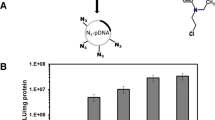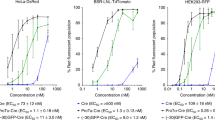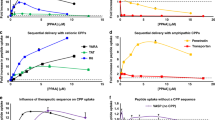Abstract
We have developed polyelectrolyte gene delivery vectors that display good extracellular stability and are activated intracellularly to permit transgene expression. The strategy comprises covalent crosslinking of primary amines in poly-L-lysine/DNA complexes with a crosslinking agent that can later be cleaved by reduction. Crosslinked complexes maintained the same size and surface charge but showed increased stability against polyelectrolyte exchange with poly-L-aspartic acid. Surface modification with polyethyleneglycol improved solubility and masked their positive surface charge. Crosslinked complexes showed 10-fold increased plasma circulation following intravenous administration to Balb/c mice. In the absence of chloroquine, the levels of transgene expression in B16F10 murine melanoma cells were similar for crosslinked and non-crosslinked complexes, however, chloroquine selectively potentiated transgene expression by the non-crosslinked complexes. Cellular uptake of the complexes was the same, irrespective of crosslinking. Following microinjection into the cytoplasm of Xenopus oocytes, or the cytoplasm or nucleus of Rat-1 fibroblasts, crosslinked complexes mediated the same transgene expression as non-crosslinked complexes, indicating crosslinked complexes are rapidly reduced and activated intracellularly. We therefore hypothesize that the lower in vitro transfection activity of crosslinked complexes in the presence of chloroquine is due to reduced transfer from endosome to cytoplasm, mainly due to increased stability against destabilization by chloroquine. The extended systemic circulation together with triggered intracellular activation makes these complexes a promising system for targeted gene delivery in vivo.
This is a preview of subscription content, access via your institution
Access options
Subscribe to this journal
Receive 12 print issues and online access
$259.00 per year
only $21.58 per issue
Buy this article
- Purchase on Springer Link
- Instant access to full article PDF
Prices may be subject to local taxes which are calculated during checkout










Similar content being viewed by others
References
Ogris M et al. PEGylated DNA/transferrin–PEI complexes: reduced interaction with blood components, extended circulation in blood and potential for systemic gene delivery Gene Therapy 1999 6: 595–605
Dash PR et al. Decreased binding to proteins and cells of polymeric gene delivery vectors surface modified with a multivalent hydrophilic polymer and retargeting through attachment of transferrin J Biol Chem 2000 275: 3793–3802
Tsuchida E, Abe K . Interactions between macromolecules in solution and intermacromolecular complexes Adv Polym Sci 1982 45: 1–119
Erbacher P, Roche AC, Monsigny M, Midoux P . Putative role of chloroquine in gene transfer into a human hepatoma cell line by DNA lactosylated polylysine complexes Exp Cell Res 1996 225: 186–194
Ogris M et al. The size of DNA/transferrin–PEI complexes is an important factor for gene expression in cultured cells Gene Therapy 1998 5: 1425–1433
Trubetskoy VS et al. Caged DNA does not aggregate in high ionic strength solutions Bioconjugate Chem 1999 10: 624–628
Oupicky D et al. Steric stabilization of poly-L-lysine/DNA complexes by covalent attachment of semitelechelic poly[N-(2-hydroxypropyl)methacrylamide] Bioconjugate Chem 2000 11: 492–501
Martin AL et al. Observation of DNA-polymer condensate formation in real time at a molecular level FEBS Lett 2000 480: 106–112
Pollard H et al. Polyethyleneimine but not cationic lipids promotes transgene delivery to the nucleus in mammalian cells J Biol Chem 1998 273: 7507–7511
Fisher KD et al. A versatile system for receptor-mediated gene delivery permits increased entry of DNA into target cells, enhanced delivery to the nucleus and elevated rates of transgene expression Gene Therapy 2000 7: 1337–1343
Ruponen M, Yla-Herttuala S, Urtti A . Interactions of polymeric and liposomal gene delivery systems with extracellular glycosaminoglycans: physicochemical and transfection studies Biochim Biophys Acta 1999 1415: 331–341
Schaffer DV, Fidelman NA, Dan N, Lauffenburger DA . Vector unpacking as a potential barrier for receptor-mediated polyplex gene delivery Biotechnol Bioeng 2000 67: 598–606
LabatMoleur F et al. An electron microscopy study into the mechanism of gene transfer with lipopolyamines Gene Therapy 1996 3: 1010–1017
Erbacher P, Roche AC, Monsigny M, Midoux P . The reduction of the positive charges of polylysine by partial gluconoylation increases the transfection efficiency of polylysine/DNA complexes Biochim Biophys Acta 1997 1324: 27–36
Kakizawa Y, Harada A, Kataoka K . Environment-sensitive stabilization of core-shell structured polyion complex micelle by reversible cross-linking of the core through disulfide bond J Am Chem Soc 1999 121: 11247–11248
McKenzie DL, Kwok KY, Rice KG . A potent new class of reductively activated peptide gene delivery agents J Biol Chem 2000 275: 9970–9977
McKenzie DL, Smiley E, Kwok KY, Rice KG . Low molecular weight disulfide cross-linking peptides as nonviral gene delivery carriers Bioconjugate Chem 2000 11: 901–909
Snyder SL, Sobocinski PZ . An improved 2,4,6-trinitrobenzenesulfonic acid method for the determination of amines Anal Biochem 1975 64: 284–288
Seymour LW et al. N-(2-hydroxypropyl)methacrylamide copolymers targeted to the hepatocyte galactose receptor: pharmacokinetics in DBA2 mice Br J Cancer 1991 63: 859–866
Acknowledgements
The support of the BBSRC by grant No. 6/B08268, the Cancer Research Campaign and the Cystic Fibrosis Trust (PJ 494) is gratefully acknowledged. We thank S Smart for Xenopus microinjections, L Oupicka for technical assistance, and M Ogris for valuable discussions.
Author information
Authors and Affiliations
Rights and permissions
About this article
Cite this article
Oupický, D., Carlisle, R. & Seymour, L. Triggered intracellular activation of disulfide crosslinked polyelectrolyte gene delivery complexes with extended systemic circulation in vivo. Gene Ther 8, 713–724 (2001). https://doi.org/10.1038/sj.gt.3301446
Received:
Accepted:
Published:
Issue Date:
DOI: https://doi.org/10.1038/sj.gt.3301446
Keywords
This article is cited by
-
Targeting the Inside of Cells with Biologicals: Chemicals as a Delivery Strategy
BioDrugs (2021)
-
Versatile DNA folding structures organized by cationic block copolymers
Polymer Journal (2019)
-
Design and characterization of a new peptide vector for short interfering RNA delivery
Journal of Nanobiotechnology (2015)
-
Polymeric Plerixafor: Effect of PEGylation on CXCR4 Antagonism, Cancer Cell Invasion, and DNA Transfection
Pharmaceutical Research (2014)
-
Bioreducible Crosslinked Polyelectrolyte Complexes for MMP-2 siRNA Delivery into Human Vascular Smooth Muscle Cells
Pharmaceutical Research (2012)



